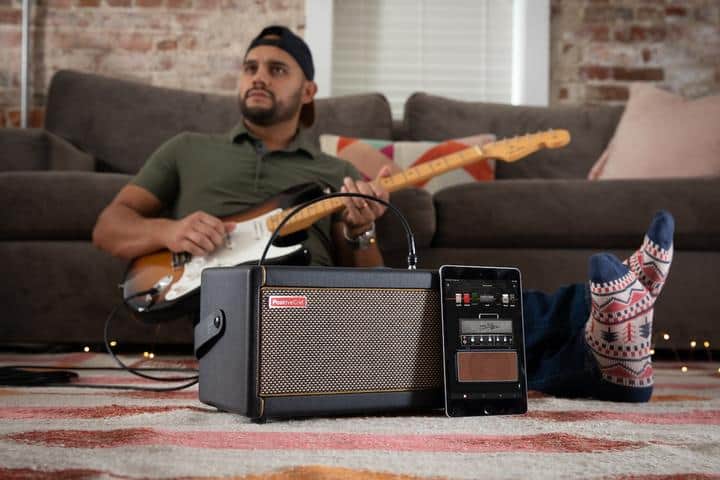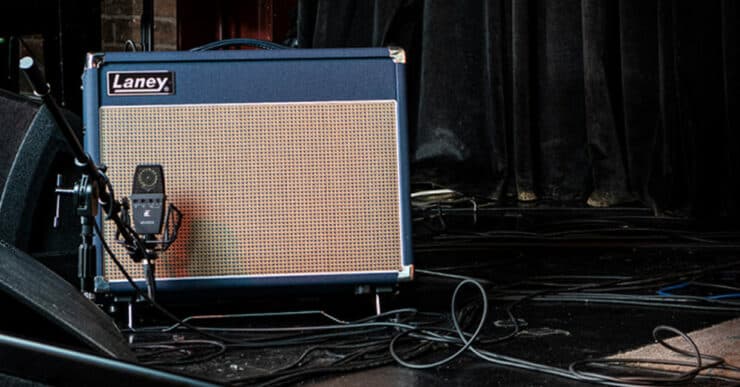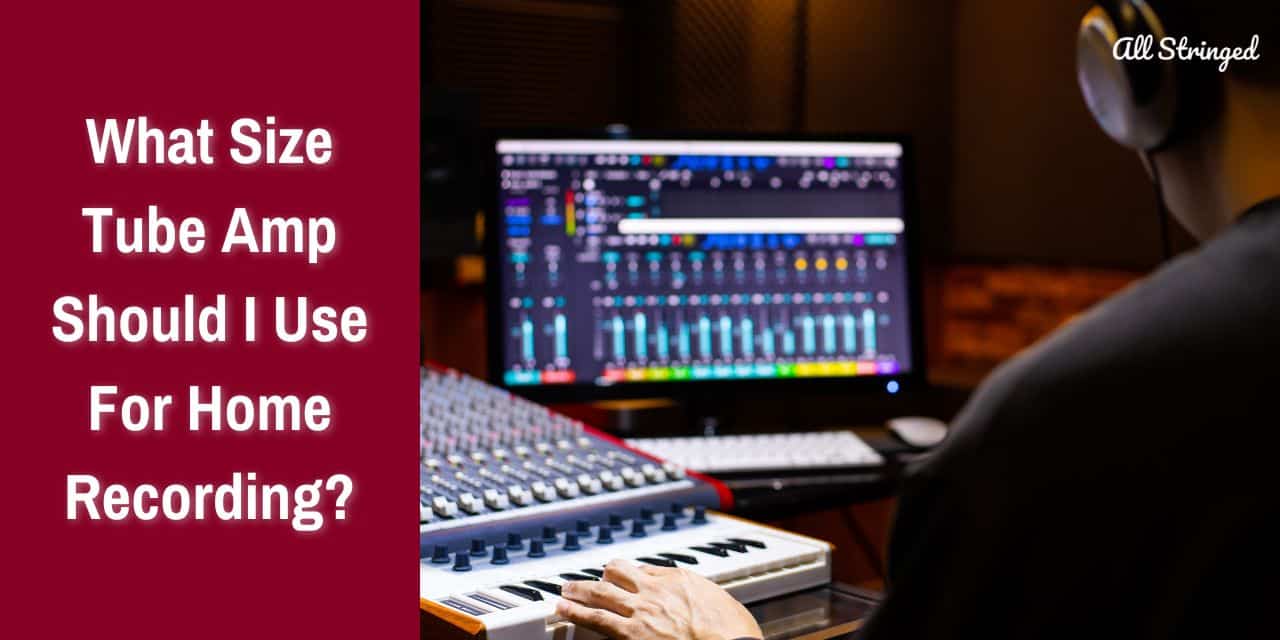Are you a guitar player looking for the perfect amp to record with at home? Choosing the right size tube amp for home recording can be a daunting task. But don’t worry, this article will provide you with all the information and tips you need to pick the ideal amp! With our guidance, you’ll have your dream amp setup in no time. So if you’re ready to get started, let’s dive in!
Overview of Tube Amps
Tube amps or also known as valve amps come with a rich history, and they’ve long been heralded for their warm, vintage sound and musical characteristics. These amps make use of vacuum tubes for amplifying audio signals and deliver a unique tonal experience.
Tube amps consist of numerous key components such as vacuum tubes, transformers, resistors, capacitors, and a power supply. Vacuum tubes are considered to be the heart of the amplifier, as they are responsible for amplifying and shaping the audio signals. Meanwhile, transformers serve to step up or step down voltage and impedance levels, making sure of proper signal transfer. Resistors and capacitors control the flow of electric charge and shape the amp’s tone and response. The power supply will provide the needed voltage and current for driving the tubes and other components.
Tube amps are renowned for their warm, rich, and dynamic sound reproduction. They offer harmonic distortion and saturation that are often perceived to be pleasing and musical, adding depth and character to the audio signal. Tube amps typically exhibit a softer clipping and smooth compression when pushed to higher volume levels, which contribute to their expressive and responsive nature.
>>> Click here to read our review about the Top 15 Best Tube Amps <<<
Tube amps tend to provide a distinctive tonal character that is normally sought out by musicians and guitarists. These devices respond to changes in playing technique and instrument dynamics with greater sensitivity and nuance. Further, they produce natural and musical overdrive when pushed, creating more pleasing harmonics. Some tube amps also boast a classic, retro design, which is particularly appealing to guitarists who appreciate vintage aesthetics.
Tube amps typically require periodic tube replacements and routine maintenance for ensuring optimal performance. Tube amps generate heat, which is why proper ventilation and cooling are essential. These devices are heavier and larger compared to their solid-state counterparts.
Benefits of tube amps for home recording
When it comes to home recording, the choice of equipment will play a key role in capturing high-quality sound. While there are numerous amp options available, tube amps will stand out as a popular choice among home recording enthusiasts and guitarists. There are numerous benefits to using tube amps for home recording. Here are some of the benefits of using tube amps for home recording, highlighting all the advantages they offer in terms of versatility, sound quality, and capturing the coveted vintage tone –

#1. Rich and warm sound
Tube amps are renowned for their ability to produce a warm, rich, and organic sound that is highly desired in recordings. The natural harmonic distortion generated by tubes will add depth and character to guitar and instrument recordings, creating a much more pleasing and musical tone.
#2. Dynamic response
Tube amps can excel in capturing the dynamic nuances of performances, offering more expressive and responsive recording. These amps respond to changes in playing technique and instrument dynamics with greater sensitivity, which allows for more natural and emotive sound reproduction.
#3. Versatility and tonal range
Tube amps offer an impressive range of tonal possibilities, making them versatile for recording different musical genres. By adjusting the amp’s settings and experimenting with mic placement, you’ll be able to achieve various tones, from clean and pristine sounds to gritty and overdriven tones.
#4. Vintage tone and character
Tube amps come with a distinct vintage vibe and tonal character, adding nostalgia and authenticity to recordings. They’re particularly well-suited for capturing classic rock, jazz, blues, and other genres that benefit from that vintage warmth and tube-driven grit.
#5. Natural compression and saturation
Tube amps naturally compress and saturate the signal when pushed, resulting in a pleasing and musical distortion. This can be quite an advantage for recording guitar solos, rhythm tracks, and other instruments where controlled overdrive and harmonics are desired
#6. Recording studio in a box
Many tube amps come equipped with speaker emulators or direct outputs, which allow for direct recording into an audio interface or mixing console. This will eliminate the need for additional mics and speaker cabinets, making the recording process much more convenient and efficient.
#7. Inspire creativity
The unique sound and feel of a tube amp can inspire musicians and guitarists during the recording process, encouraging experimentation and creation exploration. The ability to dial in different tones and capture expressive performances could enhance the overall creativity and quality of home recordings.
What size Tube Amp should I use for home recording?
Selecting the appropriate size of a tube amp is essential for achieving optimal sound quality and performance. There are various factors that come into play when making this important decision, including power requirement, speaker size, the type of music being played, and a lot more. Here are some of the key factors that will help you decide what size tube amp you should be using and take well-informed decisions –

#1. Calculate power needs
First, you will need to determine the appropriate power rating needed by considering the type of instrument, desired volume levels, and the size of the venue or room. A general rule of thumb would be to aim for an amp with a power rating that is appropriately 2–3 times the wattage needed for achieving the desired volume level. Moreover, you should also consider the efficiency rating in dB of the speakers being used, as lower-efficiency speakers might require more power for reaching the same volume level.
#2. Power needs for different types of music
Different genres and playing styles come with varying power requirements because of the dynamics and characteristics of the music. For genres having a more dynamic range, such as classical or jazz music, a higher wattage amp might be needed for accurately reproducing the full range of soft to loud passages. Genres like rock, blues, and metal will often benefit from higher wattage amps to achieve the desired distortion and sustain at higher volume levels. However, it is well worth noting that even lower wattage tube amps could offer ample volume and tonal richness when paired properly with efficient speakers.
#3. Consider the speaker size
The speaker size plays a key role in determining the overall sound and performance of the tube amp. Large speakers are capable of producing more bass responses and can handle higher power levels, which makes them suitable for genres that emphasize low-end frequencies. Smaller speakers might offer a tighter and more focused sound, which makes them ideal for genres that need quick response and clarity, such as jazz or country. You need to consider the speaker’s power handling capabilities to ensure compatibility with the amp’s power output.
#4. Room size and application
You must consider the exact size of the room or venue where the amp will be used. In smaller spaces, a lower wattage amp could also provide ample volume levels without sacrificing tone. Larger venues might require higher wattage amps to make sure sufficient projection and coverage.
#5. Personal preferences and tone
Ultimately, personal preferences and desired tone will guide your choice of tube amp size. You must experiment and try out different combinations of amps, speakers, and instruments as it’ll help you discover the perfect balance of your musical style and preferences.
Different types of tube amps
There are different types of guitar amps available in the market and tube amps are one of the most popular options. Even the tube amps come in several different types. With various designs and configurations available, understanding the different types of tube amps will be essential to find the right one to match your musical preferences and needs. Here are some of the common types of tube amplifiers, their unique characteristics, and the musical styles in which they excel –

#1. Single-ended tube amps
Single-ended tube amps come with a simple circuit design, having a single power tube. These amps are capable of producing low to moderate power output, which makes them ideal for home or studio use. Single-ended tube amps are known best for their rich and harmonic content, smooth distortion, and warm, vintage tone. They can excel in reproducing clean and slightly overdriven tones, making them quite popular for jazz, blues, and other genres that prioritize nuanced and expressive playing.
#2. Push-pull tube amps
Push-pull tube amps can prioritize two power tubes that work together in a balanced configuration. These amps are capable of offering higher power output and cleaner performance compared to single-ended amps. Push-pull designs reduce distortion and offer a tighter bass response and improved headroom. Moreover, these amps are incredibly versatile and they can cover a wide range of musical styles, from clean and pristine tones to moderate levels of overdrive. Push-pull tube amps are also commonly used in rich, country, and blues genres, where higher volume levels and dynamic response are desired.
#3. Class A tube amps
Class A tube amps feature a single power tube that operates continuously, providing a pure and uncompromised audio signal. They can deliver a rich and harmonically complex sound, with smooth distortion and excellent responsiveness. Class A tube amps are often associated with vintage and boutique designs, favored by guitarists and audiophiles. Moreover, they also excel in delivering clean, pristine tones with a sweet breakup when pushed, making them well-suited for blues, jazz, and classic rock.
#4. Class AB and Class B tube amps
Class AB and Class B tube amps make use of two power tubes that alternate their operation. Class AB amps have a slight overlap in tube operation, offering improved efficiency and power handling. Class B amps have no overlap, resulting in higher power output but with increased crossover distortion. These types of amps are typically used in rock, metal, and high-gain applications where higher volumes, aggressive tones, and tight bass response are desired.
#5. Boutique and custom tube amps
Boutique and custom tube amps are handcrafted, often coming with unique circuit designs and high-quality components. Moreover, these amps offer tremendous build quality, attention to detail, and personalized tonal characteristics. Boutique and custom tube amps cater to specific genres and player preferences, offering a tailored sound and feel. These amps are sought after by discerning musicians and collectors who appreciate the artistry and craftsmanship behind these amps.
Tips for using a tube amp for home recording
Using a tube amp for home recording can be a great way of capturing warm, rich, and authentic tones. For making the most of your tube amp in a recording setting, proper setup, and recording techniques will be essential. Here, you will get to explore some handy tips and suggestions that will help you achieve professional-quality tones and results from your tube amp in your home studio –
#1. Amp setup
You need to place your tube amp in an acoustically treated area or use isolation techniques for minimizing unwanted room reflections and external noise. Experiment with mic placement to find the sweet spot that captures the desired tone and character of the amp. Some of the common microphone placements include close-miking the speaker cone, capturing room ambiance with a distant mic, and off-axis positioning for a smoother sound.
You should make sure that the tube amp is properly grounded so that you can avoid noise interference or hum issues. Take your time to dial in the amp settings, adjusting the gain, EQ, and any other effects for achieving the desired tone. Further, you should also experiment with different settings for finding the perfect balance for your recording.
#2. Recording the tone
You need to prioritize capturing the best tone at the source. Spend some time finding out the optimal amp settings and experiment with different guitars and pedals for achieving the desired sound before recording. Consider using a high-quality Direct Input (DI) box to simultaneously capture a clean signal from your amp for re-amping or further processing during mixing. Make use of the natural characteristics of the tube amp to your advantage.
Play with different dynamics or explore the tube amp’s responsiveness and achieve expressive performances. You shouldn’t be afraid of experimenting with different types of microphones, such as dynamic condensers, ribbon microphones, and more to capture different tonal nuances and textures.
#3. Recording techniques
Experimenting with layering multiple guitar tracks for creating a thicker and much more impactful sound. Record additional takes for adding depth, harmonies, or doubled parts. Moreover, you can make use of overdubbing techniques for adding guitar solos, fills, and additional parts to enhance the overall arrangement.
You can also consider amp simulation plugins or hardware units with your tube amp for exploring different tones and effects, or to blend amp sounds for added versatility. Place a mic away from the amp for capturing the room’s natural ambiance. This can add some depth and dimension to your recordings. Experiment with different close-miking techniques for capturing the amp’s direct sound. Further, you should also be adjusting the mic position for finding the sweet spot that perfectly captures the desired characteristics of the amp and speaker combination.
#4. Monitoring and mixing
Make use of high-quality monitors or headphones for accurately monitoring your recordings during mixing. You can easily take advantage of EQ, compression, and other processing tools for shaping the recorded guitar tracks and achieving a polished sound. Pay close attention to phase coherence when you are blending multiple mic recordings. Align the phase of the tracks so that you can avoid cancelation or phase-related issues. Apply appropriate reverb or delay effects for creating a sense of space and depth in the mix.
FAQs
What size tube amp should I use for home recording?
The size of tube amp you should use for home recording will depend on the size and acoustics of the room you are recording in, as well as the type of sound you are looking for. If you are recording in a small space, a smaller tube amp may be more suitable. If you are looking for a more powerful sound, a larger tube amp may be a better option.
What are the benefits of using a tube amp for home recording?
Tube amps provide a warm and dynamic sound that is well-suited for home recording. They also offer a more organic and natural sound compared to other types of amplifiers, making them ideal for recording.
What other considerations should I keep in mind when choosing a tube amp for home recording?
In addition to the size of the amp, you should also consider the type of tubes, the power output, and the features offered. You should also consider your budget and the available space for storage. By considering all of these factors, you can ensure you choose the right tube amp for your recording needs.



